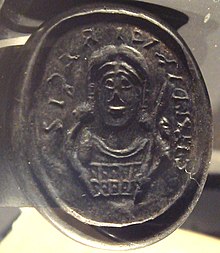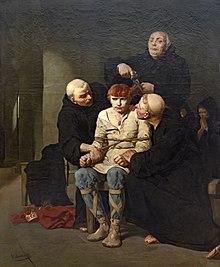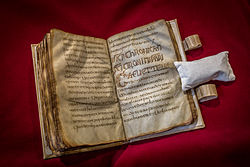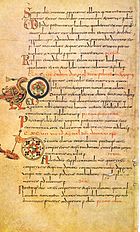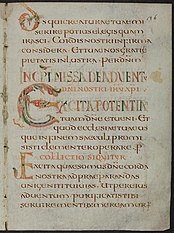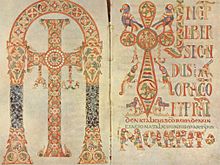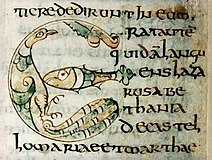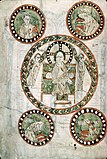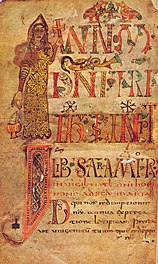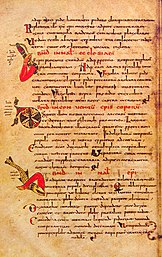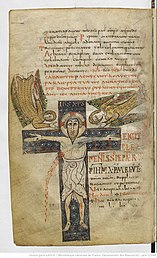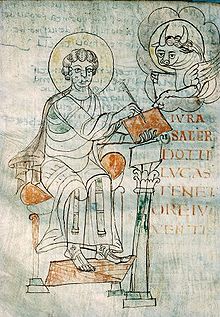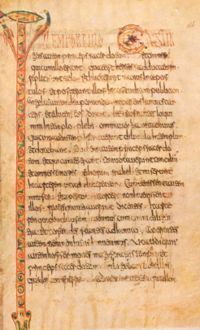
Ebroin was the Frankish mayor of the palace of Neustria on two occasions; firstly from 658 to his deposition in 673 and secondly from 675 to his death in 680 or 681. In a violent and despotic career, he strove to impose the authority of Neustria, which was under his control, over Burgundy and Austrasia.

The Book of Kells is an illuminated manuscript Gospel book in Latin, containing the four Gospels of the New Testament together with various prefatory texts and tables. It was created in a Columban monastery in either Ireland, Scotland or England, and may have had contributions from various Columban institutions from each of these areas. It is believed to have been created c. 800 AD. The text of the Gospels is largely drawn from the Vulgate, although it also includes several passages drawn from the earlier versions of the Bible known as the Vetus Latina. It is regarded as a masterwork of Western calligraphy and the pinnacle of Insular illumination. The manuscript takes its name from the Abbey of Kells, County Meath, which was its home for centuries.

The Book of Durrow is an illuminated manuscript dated to c. 700 that consists of text from the four Gospels gospel books, written in an Irish adaption of Vulgate Latin, and illustrated in the Insular script style.
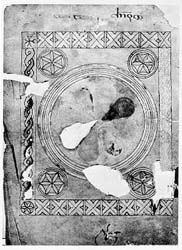
The Bobbio Orosius is an early 7th century Insular manuscript of the Chronicon of Paulus Orosius. The manuscript has 48 folios and measures 210 by 150 mm. It is thought to have been produced at the scriptorium of Bobbio Abbey, which was founded by Saint Columbanus in 612. It appears in an inventory of the monastic library done in 1461. The monks gave the manuscript to the Ambrosian Library when it was founded in 1606 by Cardinal Federico Borromeo.
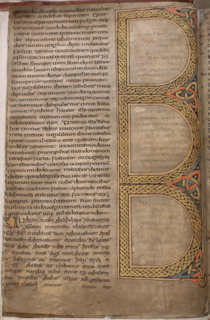
Durham Cathedral Library, Manuscript A.II.10. is a fragmentary seventh century Insular Gospel Book, produced in Lindisfarne c. 650. Only seven leaves of the book survive, bound in three separate volumes in the Durham Cathedral Dean and Chapter Library. Although this book is fragmentary, it is the earliest surviving example in the series of lavish Insular Gospel Books which includes the Book of Durrow, the Lindisfarne Gospels, the St. Teilo Gospels and the Book of Kells.
In the Western Church of the Early and High Middle Ages, a sacramentary was a book used for liturgical services and the mass by a bishop or priest. Sacramentaries include only the words spoken or sung by him, unlike the missals of later centuries that include all the texts of the mass whether read by the bishop, priest, or others. Also, sacramentaries, unlike missals, include texts for services other than the mass such as ordinations, the consecration of a church or altar, exorcisms, and blessings, all of which were later included in Pontificals and Rituals instead.

Corbie is a commune of the Somme department in Hauts-de-France in northern France.
Merovingian script or Gallo-Roman script was a medieval variant of the Latin script so called because it was developed in Gaul during the Merovingian dynasty. It was used in the 7th and 8th centuries before the Carolingian dynasty and the development of Carolingian minuscule.

The so-called Gelasian Sacramentary is a book of Christian liturgy, containing the priest's part in celebrating the Eucharist. It is the second oldest western liturgical book that has survived: only the Verona Sacramentary is older.
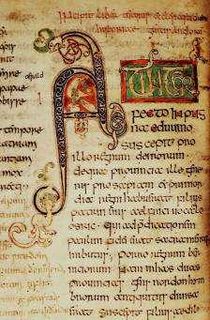
British Library, MS Cotton Tiberius C. II, or the Tiberius Bede, is an 8th-century illuminated manuscript of Bede's Historia ecclesiastica gentis Anglorum. It is one of only four surviving 8th-century manuscripts of Bede, another of which happens to be MS Cotton Tiberius A. XIV, produced at Monkwearmouth–Jarrow Abbey. As such it is one of the closest texts to Bede's autograph. The manuscript has 155 vellum folios. This manuscript may have been the Latin text on which the Alfredian Old English translation of Bede's Ecclesiastical History was based. The manuscript is decorated with zoomorphic initials in a partly Insular and partly Continental style.

Pre-Romanesque art and architecture is the period in European art from either the emergence of the Merovingian kingdom in about 500 AD or from the Carolingian Renaissance in the late 8th century, to the beginning of the 11th century Romanesque period. The term is generally used in English only for architecture and monumental sculpture, but here all the arts of the period are briefly described.

The Gallican Rite is a historical version of Christian liturgy and other ritual practices in Western Christianity. It is not a single rite but a family of rites within the Latin Church, which comprised the majority use of most of Western Christianity for the greater part of the 1st millennium AD. The rites first developed in the early centuries as the Syriac-Greek rites of Jerusalem and Antioch and were first translated into Latin in various parts of the Western Roman Empire Praetorian prefecture of Gaul. By the 5th century, it was well established in the Roman civil diocese of Gaul, which had a few early centers of Christianity in the south. Ireland is also known to have had a form of this Gallican Liturgy mixed with Celtic customs.
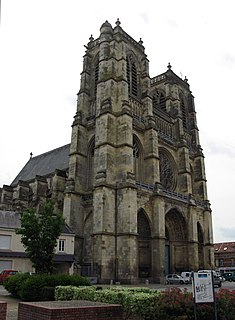
Corbie Abbey is a former Benedictine monastery in Corbie, Picardy, France, dedicated to Saint Peter. It was founded by Balthild, the widow of Clovis II, who had monks sent from Luxeuil. The Abbey of Corbie became celebrated both for its library and the scriptorium.

Merovingian art is the art of the Merovingian dynasty of the Franks, which lasted from the 5th century to the 8th century in present-day France, Benelux and a part of Germany. The advent of the Merovingian dynasty in Gaul in the 5th century led to important changes in the field of arts. Sculpture regressed to be little more than a simple technique for the ornamentation of sarcophagi, altars and ecclesiastical furniture. On the other hand, gold work and the new medium of manuscript illumination integrated "barbarian" animal-style decoration, with Late Antique motifs, and other contributions from as far as Syria or Ireland to constitute Merovingian art.

Insular art, also known as Hiberno-Saxon art, was produced in the post-Roman era of Great Britain and Ireland. The term derives from insula, the Latin term for "island"; in this period Britain and Ireland shared a largely common style different from that of the rest of Europe. Art historians usually group Insular art as part of the Migration Period art movement as well as Early Medieval Western art, and it is the combination of these two traditions that gives the style its special character.

Chelles Abbey was a Frankish monastery founded around 657/660 during the early medieval period. It was intended initially as a monastery for women; then its reputation for great learning grew, and with the afflux of men wishing to follow the monastic life, a parallel male community was established, creating a double monastery.

Insular illumination refers to the production of illuminated manuscripts in the monasteries of Ireland and Great Britain between the 6th and 9th centuries, as well as in monasteries under their influence on continental Europe. It is characterised by decoration strongly influenced by metalwork, the constant use of interlacing, and the importance assigned to calligraphy. The most celebrated books of this sort are largely gospel books. Around sixty manuscripts are known from this period.

The Gundohinus Gospels is an illuminated Gospel Book of 754–755 named after its scribe Gundohinus. It contains one of the earliest figures in a Frankish manuscript and is now in the town library in Autun. It is often held as an example of the new Frankish-papal alliance's opposition to Byzantine iconoclasm.
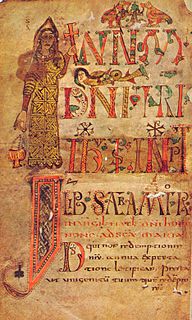
Gellone Sacramentary is a late 8th century illuminated manuscript. It is now in the manuscripts department of the Bibliotheque Nationale de France, shelfmark Latin 12048. It is recorded in Saint-Guilhem-le-Désert Abbey at the start of the 9th century. Its style is directly influenced by Merovingian illumination.

